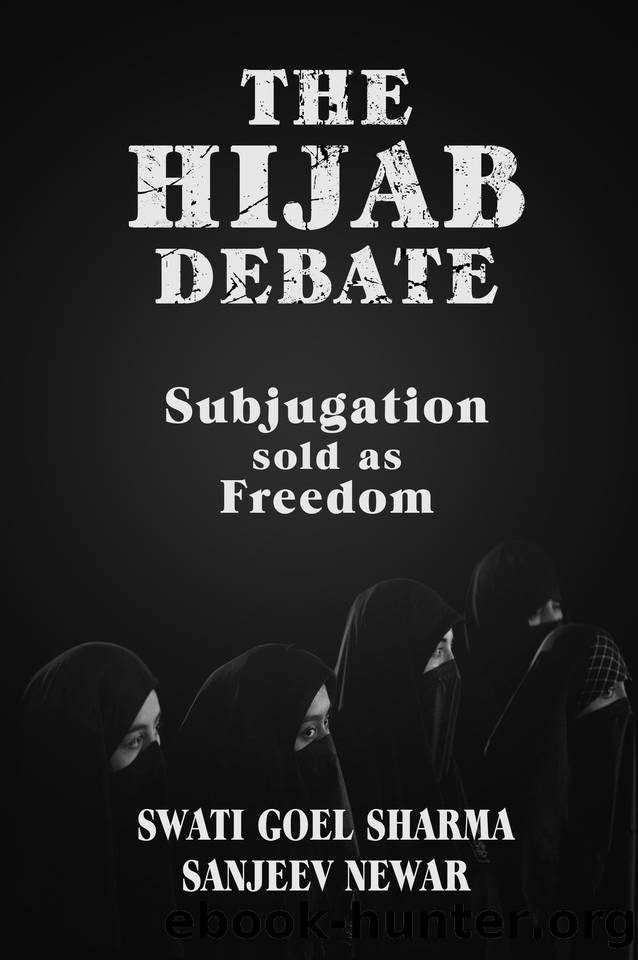The Hijab Debate: Subjugation sold as Freedom by Newar Sanjeev & Goel Sharma Swati

Author:Newar, Sanjeev & Goel Sharma, Swati [Newar, Sanjeev & Goel Sharma, Swati]
Language: eng
Format: epub
Publisher: Ritvijam
Published: 2022-10-08T18:30:00+00:00
Back to Dark Era?
In the 19th century, the Indian society was greatly influenced by the Western culture under the British Raj that had ended the Mughal Empire.
Islamic scholars during this period wrote scathing criticisms of âWestern valuesâ that had destroyed âIslamic valuesâ and passionately appealed to Muslim women to don the burqa.
Maulana Ashraf Ali Thanwi (1864-1943) wrote Bahishti Zewar (Heavenly Ornaments)[193] for Muslim women. Itâs a book that continues to be a rage in India and Pakistan more than a century later.
Thanwi was an alumnus of Darul Uloom Deoband.
âPurdah is one of the most important of obligatory acts,â he wrote[194] (English translation from Urdu by Muhammad Mahomedy, Zam Zam Publishers, Karachi, Pakistan, 2005 edition).
Following are excerpts from the chapter Purdah and Clothing:
Women are ordered to cover their bodies from head to toe.
It is not permissible for them to expose their bodies to ghayr mahrams. However, it is permissible for an old woman to expose her face, palms, and feet below the ankles. It is not permissible for her to expose the rest of her body. At times the head covering falls off slightly and she goes in the presence of ghayr mahrams in this way. This is not permissible.
(In Islam, âghayr Mahramsâ are men with whom marriage or sexual relationship is not permissible in Islam. They may be some relatives, or friends or relatives of husband, or non-Muslims).
It is not permissible for a young woman to expose her face in the presence of ghayr mahrams, nor should she stand in a place where she could be observed.
If there is a dire need, it will be permissible to expose that part of the body which is necessary to expose. For example, if a woman has a boil on her thigh, it will be permissible for her to expose just that area where the boil is situated. Under no condition should she expose more than that area. This could be done by wearing a very old pants or sheet and cutting that area of the pants where the boil is situated.
It is wajib to make purdah with the kaafir women who come into one's home. This also applies to maids and domestic servants who are not Muslims. The purdah that has to be made with them is the same as that which has to be made with ghayr mahram males.
In 1939, Maulana Abul Ala Al-Maududi wrote a book titled Purdah and The Status of Women in Islam[195], which went on to become a huge influencer.
Before we elaborate what Maududi argued, a brief introduction of the man is important.
Born in 1903 in Aurangabad into a family that claimed descent from Afghanistan and the Chishti order, Maududi was a fundamentalist Muslim theologian who is today considered one of the most powerful Islamic ideologies of the 20th century.
In 1941, Maududi founded Jamaat-e-Islami, which became the largest Islamic organisation in Asia and played a major role in Pakistan politics after he moved there post partition. Maududi is credited[196] with âpoliticisingâ Islam and is said to be an inspiration behind new-age Islamic movements such as the Muslim Brotherhood.
Download
This site does not store any files on its server. We only index and link to content provided by other sites. Please contact the content providers to delete copyright contents if any and email us, we'll remove relevant links or contents immediately.
| Hadith | History |
| Law | Mecca |
| Muhammed | Quran |
| Rituals & Practice | Shi'ism |
| Sufism | Sunnism |
| Theology | Women in Islam |
The History of Jihad: From Muhammad to ISIS by Spencer Robert(2564)
Nine Parts of Desire by Geraldine Brooks(2325)
The Turkish Psychedelic Explosion by Daniel Spicer(2313)
The First Muslim The Story of Muhammad by Lesley Hazleton(2217)
The Essential Rumi by Coleman Barks(1987)
1453 by Roger Crowley(1955)
The Last Mughal by William Dalrymple(1828)
Trickster Travels: A Sixteenth-Century Muslim Between Worlds by Davis Natalie Zemon(1813)
God by Aslan Reza(1610)
Muhammad: His Life Based on the Earliest Sources by Martin Lings(1605)
by Christianity & Islam(1594)
A Concise History of Sunnis and Shi'is by John McHugo(1545)
Magic and Divination in Early Islam by Emilie Savage-Smith;(1498)
No God But God by Reza Aslan(1488)
The Flight of the Intellectuals by Berman Paul(1461)
Art of Betrayal by Gordon Corera(1399)
Nothing to Envy by Barbara Demick(1383)
What the Qur'an Meant by Garry Wills(1359)
Getting Jesus Right: How Muslims Get Jesus and Islam Wrong by James A Beverley & Craig A Evans(1307)
